Management Environment Report: Supermarket Price War & BVI Analysis
VerifiedAdded on 2020/04/21
|24
|5440
|77
Report
AI Summary
This report presents an analysis of the management environment, encompassing two primary case studies. The first section delves into the UK supermarket industry, examining the competitive landscape, particularly the price war dynamics among major players like Tesco, Asda, Sainsbury's, Morrisons, Aldi, and Lidl. It applies a game-theoretic framework to explain the strategic decisions and outcomes of price competition within an oligopolistic market structure. The second part of the report shifts focus to the British Virgin Islands (BVI), assessing the impact of Hurricane Irma on the economy. It explores the hurricane's effects on the BVI's infrastructure, economic activities, and uses GDP as a welfare indicator to assess the overall impact. Furthermore, the report includes a business model canvas for the Manchester College, evaluating its key partnerships, activities, value propositions, customer relationships, segments, resources, channels, cost structure, and revenue streams, highlighting areas for improvement and strategic expansion.
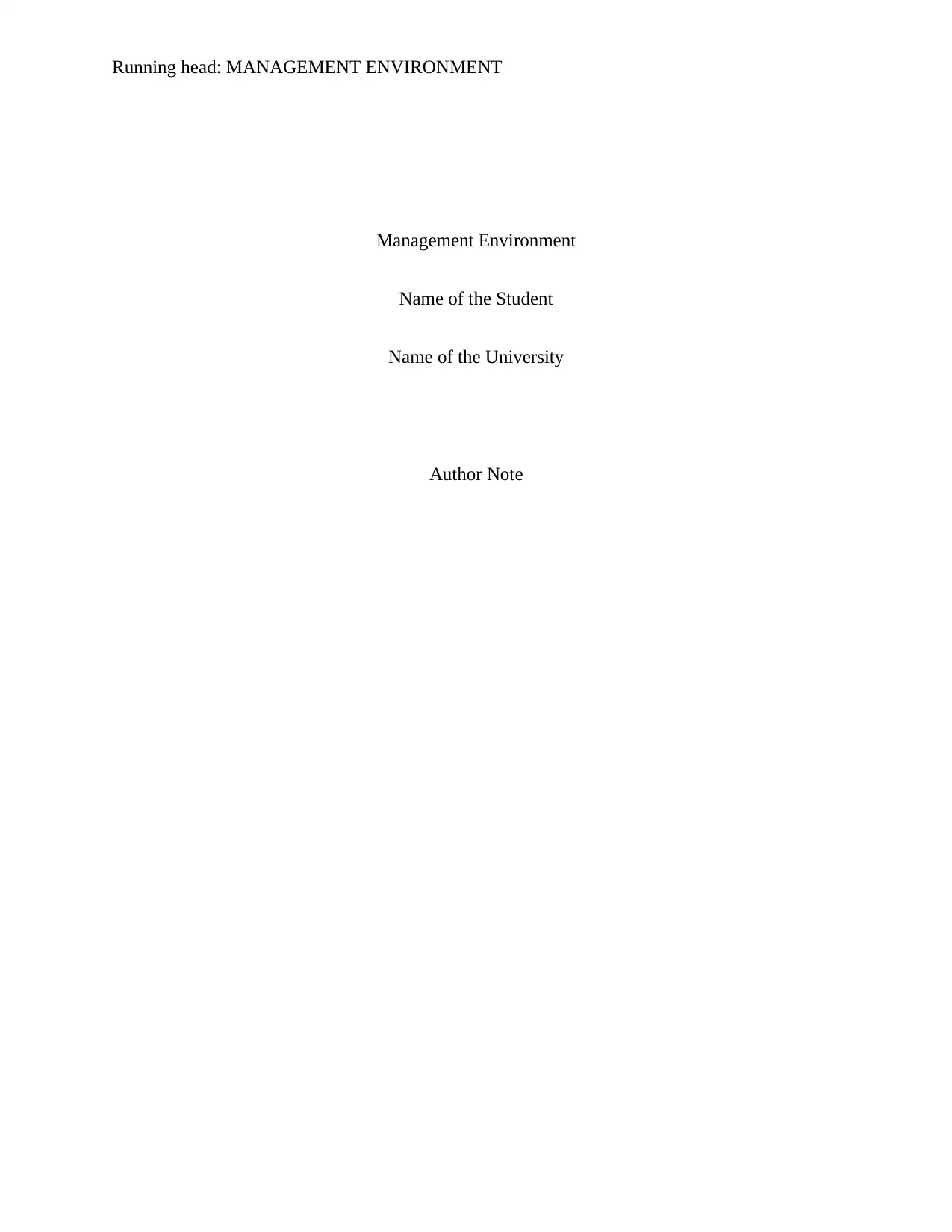
Running head: MANAGEMENT ENVIRONMENT
Management Environment
Name of the Student
Name of the University
Author Note
Management Environment
Name of the Student
Name of the University
Author Note
Paraphrase This Document
Need a fresh take? Get an instant paraphrase of this document with our AI Paraphraser
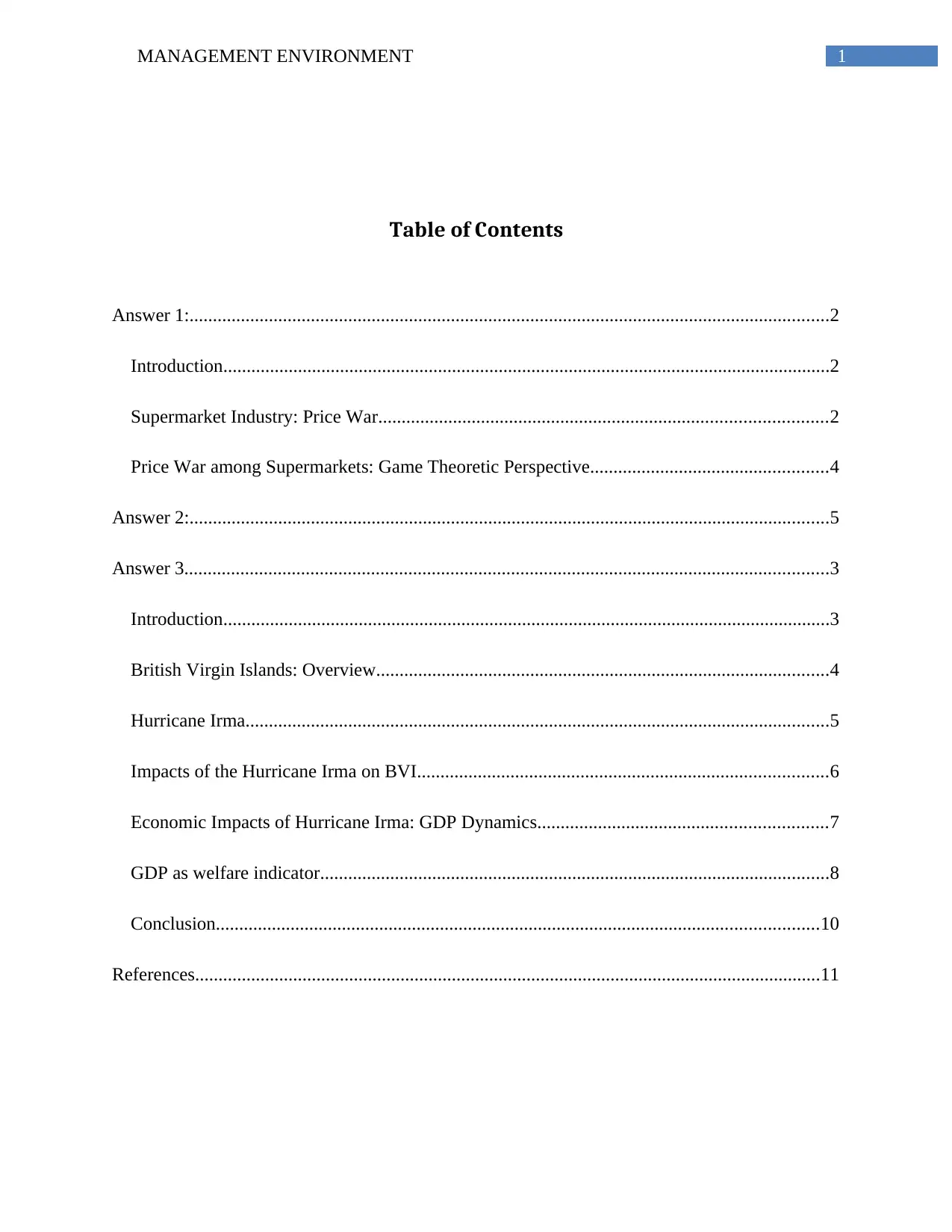
1MANAGEMENT ENVIRONMENT
Table of Contents
Answer 1:.........................................................................................................................................2
Introduction..................................................................................................................................2
Supermarket Industry: Price War................................................................................................2
Price War among Supermarkets: Game Theoretic Perspective...................................................4
Answer 2:.........................................................................................................................................5
Answer 3..........................................................................................................................................3
Introduction..................................................................................................................................3
British Virgin Islands: Overview.................................................................................................4
Hurricane Irma.............................................................................................................................5
Impacts of the Hurricane Irma on BVI........................................................................................6
Economic Impacts of Hurricane Irma: GDP Dynamics..............................................................7
GDP as welfare indicator.............................................................................................................8
Conclusion.................................................................................................................................10
References......................................................................................................................................11
Table of Contents
Answer 1:.........................................................................................................................................2
Introduction..................................................................................................................................2
Supermarket Industry: Price War................................................................................................2
Price War among Supermarkets: Game Theoretic Perspective...................................................4
Answer 2:.........................................................................................................................................5
Answer 3..........................................................................................................................................3
Introduction..................................................................................................................................3
British Virgin Islands: Overview.................................................................................................4
Hurricane Irma.............................................................................................................................5
Impacts of the Hurricane Irma on BVI........................................................................................6
Economic Impacts of Hurricane Irma: GDP Dynamics..............................................................7
GDP as welfare indicator.............................................................................................................8
Conclusion.................................................................................................................................10
References......................................................................................................................................11
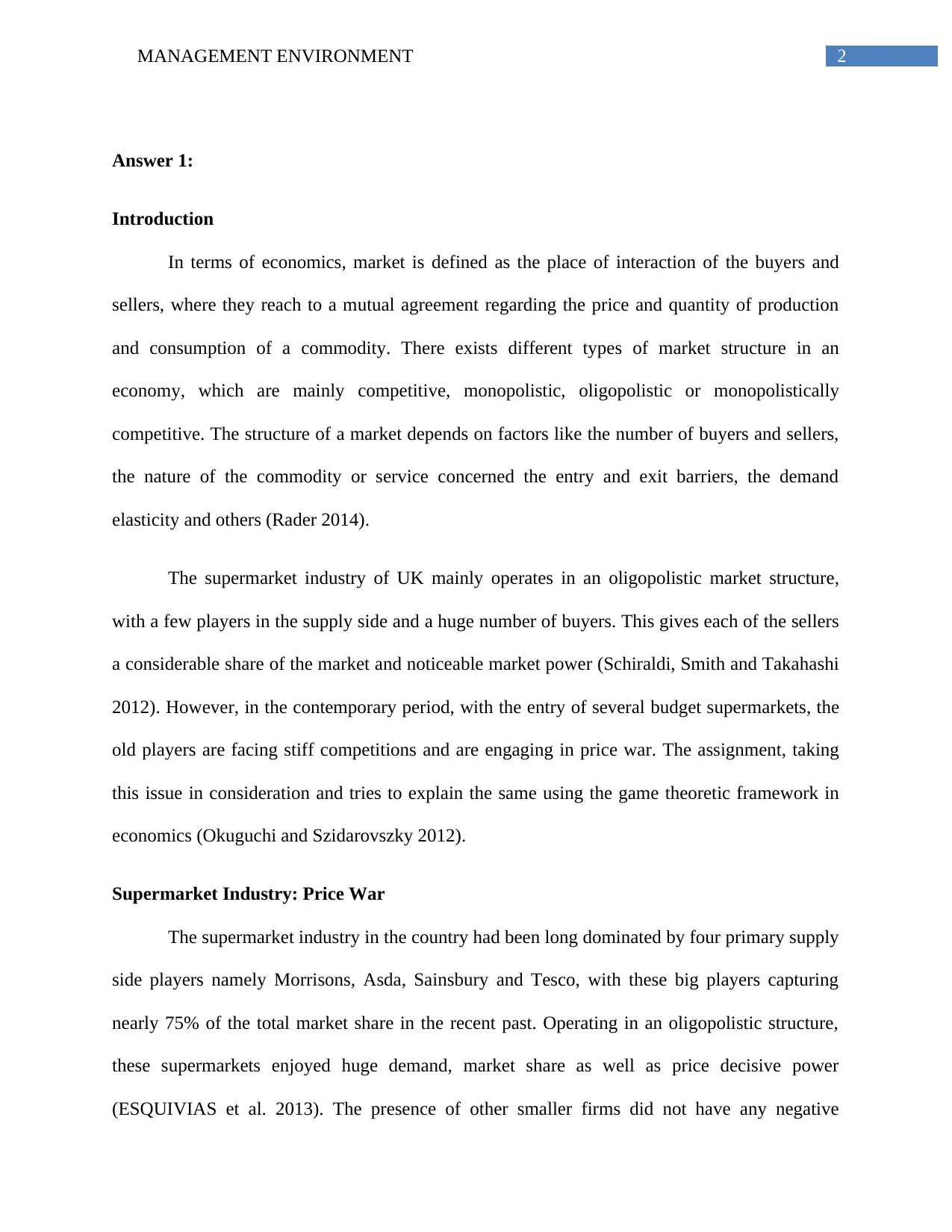
2MANAGEMENT ENVIRONMENT
Answer 1:
Introduction
In terms of economics, market is defined as the place of interaction of the buyers and
sellers, where they reach to a mutual agreement regarding the price and quantity of production
and consumption of a commodity. There exists different types of market structure in an
economy, which are mainly competitive, monopolistic, oligopolistic or monopolistically
competitive. The structure of a market depends on factors like the number of buyers and sellers,
the nature of the commodity or service concerned the entry and exit barriers, the demand
elasticity and others (Rader 2014).
The supermarket industry of UK mainly operates in an oligopolistic market structure,
with a few players in the supply side and a huge number of buyers. This gives each of the sellers
a considerable share of the market and noticeable market power (Schiraldi, Smith and Takahashi
2012). However, in the contemporary period, with the entry of several budget supermarkets, the
old players are facing stiff competitions and are engaging in price war. The assignment, taking
this issue in consideration and tries to explain the same using the game theoretic framework in
economics (Okuguchi and Szidarovszky 2012).
Supermarket Industry: Price War
The supermarket industry in the country had been long dominated by four primary supply
side players namely Morrisons, Asda, Sainsbury and Tesco, with these big players capturing
nearly 75% of the total market share in the recent past. Operating in an oligopolistic structure,
these supermarkets enjoyed huge demand, market share as well as price decisive power
(ESQUIVIAS et al. 2013). The presence of other smaller firms did not have any negative
Answer 1:
Introduction
In terms of economics, market is defined as the place of interaction of the buyers and
sellers, where they reach to a mutual agreement regarding the price and quantity of production
and consumption of a commodity. There exists different types of market structure in an
economy, which are mainly competitive, monopolistic, oligopolistic or monopolistically
competitive. The structure of a market depends on factors like the number of buyers and sellers,
the nature of the commodity or service concerned the entry and exit barriers, the demand
elasticity and others (Rader 2014).
The supermarket industry of UK mainly operates in an oligopolistic market structure,
with a few players in the supply side and a huge number of buyers. This gives each of the sellers
a considerable share of the market and noticeable market power (Schiraldi, Smith and Takahashi
2012). However, in the contemporary period, with the entry of several budget supermarkets, the
old players are facing stiff competitions and are engaging in price war. The assignment, taking
this issue in consideration and tries to explain the same using the game theoretic framework in
economics (Okuguchi and Szidarovszky 2012).
Supermarket Industry: Price War
The supermarket industry in the country had been long dominated by four primary supply
side players namely Morrisons, Asda, Sainsbury and Tesco, with these big players capturing
nearly 75% of the total market share in the recent past. Operating in an oligopolistic structure,
these supermarkets enjoyed huge demand, market share as well as price decisive power
(ESQUIVIAS et al. 2013). The presence of other smaller firms did not have any negative
⊘ This is a preview!⊘
Do you want full access?
Subscribe today to unlock all pages.

Trusted by 1+ million students worldwide
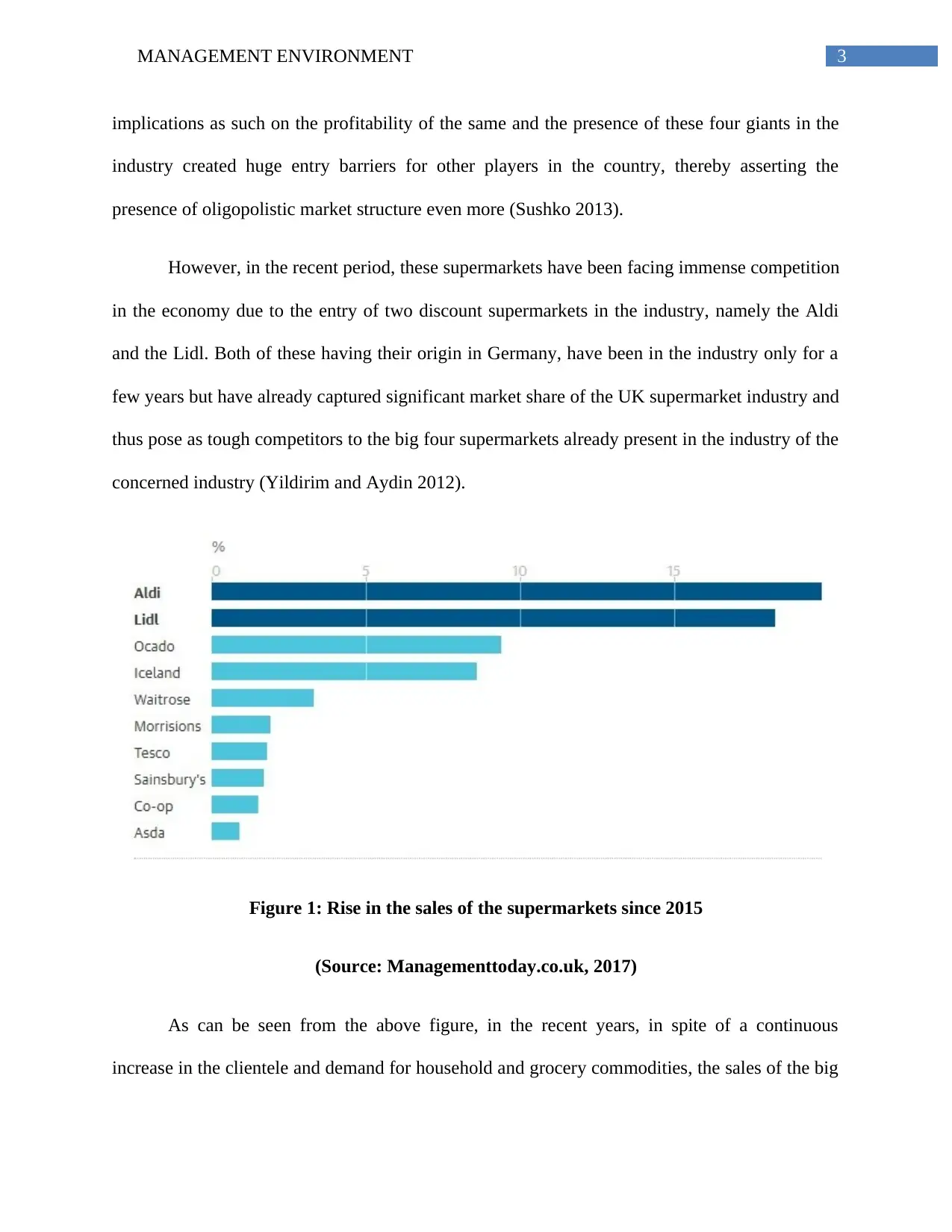
3MANAGEMENT ENVIRONMENT
implications as such on the profitability of the same and the presence of these four giants in the
industry created huge entry barriers for other players in the country, thereby asserting the
presence of oligopolistic market structure even more (Sushko 2013).
However, in the recent period, these supermarkets have been facing immense competition
in the economy due to the entry of two discount supermarkets in the industry, namely the Aldi
and the Lidl. Both of these having their origin in Germany, have been in the industry only for a
few years but have already captured significant market share of the UK supermarket industry and
thus pose as tough competitors to the big four supermarkets already present in the industry of the
concerned industry (Yildirim and Aydin 2012).
Figure 1: Rise in the sales of the supermarkets since 2015
(Source: Managementtoday.co.uk, 2017)
As can be seen from the above figure, in the recent years, in spite of a continuous
increase in the clientele and demand for household and grocery commodities, the sales of the big
implications as such on the profitability of the same and the presence of these four giants in the
industry created huge entry barriers for other players in the country, thereby asserting the
presence of oligopolistic market structure even more (Sushko 2013).
However, in the recent period, these supermarkets have been facing immense competition
in the economy due to the entry of two discount supermarkets in the industry, namely the Aldi
and the Lidl. Both of these having their origin in Germany, have been in the industry only for a
few years but have already captured significant market share of the UK supermarket industry and
thus pose as tough competitors to the big four supermarkets already present in the industry of the
concerned industry (Yildirim and Aydin 2012).
Figure 1: Rise in the sales of the supermarkets since 2015
(Source: Managementtoday.co.uk, 2017)
As can be seen from the above figure, in the recent years, in spite of a continuous
increase in the clientele and demand for household and grocery commodities, the sales of the big
Paraphrase This Document
Need a fresh take? Get an instant paraphrase of this document with our AI Paraphraser
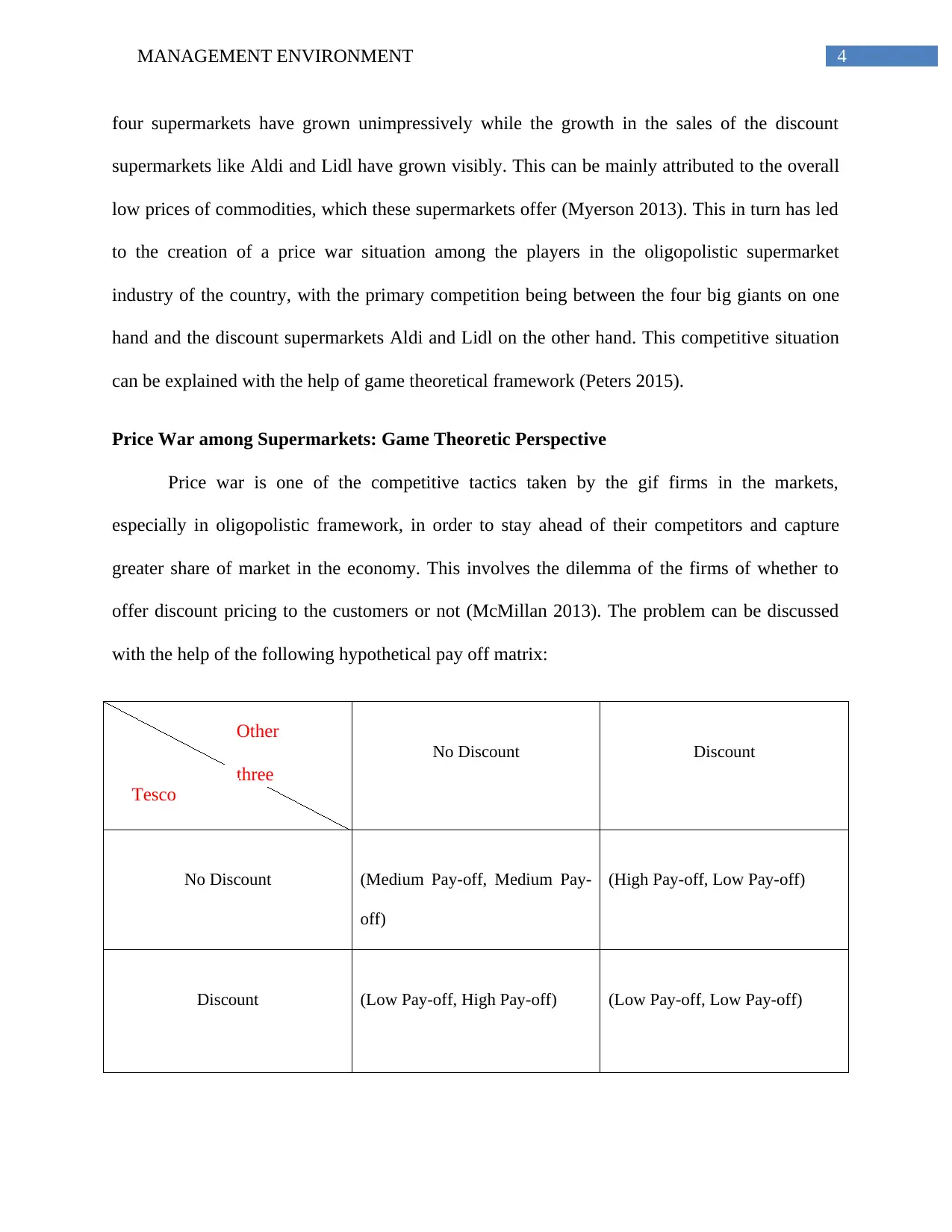
4MANAGEMENT ENVIRONMENT
four supermarkets have grown unimpressively while the growth in the sales of the discount
supermarkets like Aldi and Lidl have grown visibly. This can be mainly attributed to the overall
low prices of commodities, which these supermarkets offer (Myerson 2013). This in turn has led
to the creation of a price war situation among the players in the oligopolistic supermarket
industry of the country, with the primary competition being between the four big giants on one
hand and the discount supermarkets Aldi and Lidl on the other hand. This competitive situation
can be explained with the help of game theoretical framework (Peters 2015).
Price War among Supermarkets: Game Theoretic Perspective
Price war is one of the competitive tactics taken by the gif firms in the markets,
especially in oligopolistic framework, in order to stay ahead of their competitors and capture
greater share of market in the economy. This involves the dilemma of the firms of whether to
offer discount pricing to the customers or not (McMillan 2013). The problem can be discussed
with the help of the following hypothetical pay off matrix:
No Discount Discount
No Discount (Medium Pay-off, Medium Pay-
off)
(High Pay-off, Low Pay-off)
Discount (Low Pay-off, High Pay-off) (Low Pay-off, Low Pay-off)
Other
three
Tesco
four supermarkets have grown unimpressively while the growth in the sales of the discount
supermarkets like Aldi and Lidl have grown visibly. This can be mainly attributed to the overall
low prices of commodities, which these supermarkets offer (Myerson 2013). This in turn has led
to the creation of a price war situation among the players in the oligopolistic supermarket
industry of the country, with the primary competition being between the four big giants on one
hand and the discount supermarkets Aldi and Lidl on the other hand. This competitive situation
can be explained with the help of game theoretical framework (Peters 2015).
Price War among Supermarkets: Game Theoretic Perspective
Price war is one of the competitive tactics taken by the gif firms in the markets,
especially in oligopolistic framework, in order to stay ahead of their competitors and capture
greater share of market in the economy. This involves the dilemma of the firms of whether to
offer discount pricing to the customers or not (McMillan 2013). The problem can be discussed
with the help of the following hypothetical pay off matrix:
No Discount Discount
No Discount (Medium Pay-off, Medium Pay-
off)
(High Pay-off, Low Pay-off)
Discount (Low Pay-off, High Pay-off) (Low Pay-off, Low Pay-off)
Other
three
Tesco
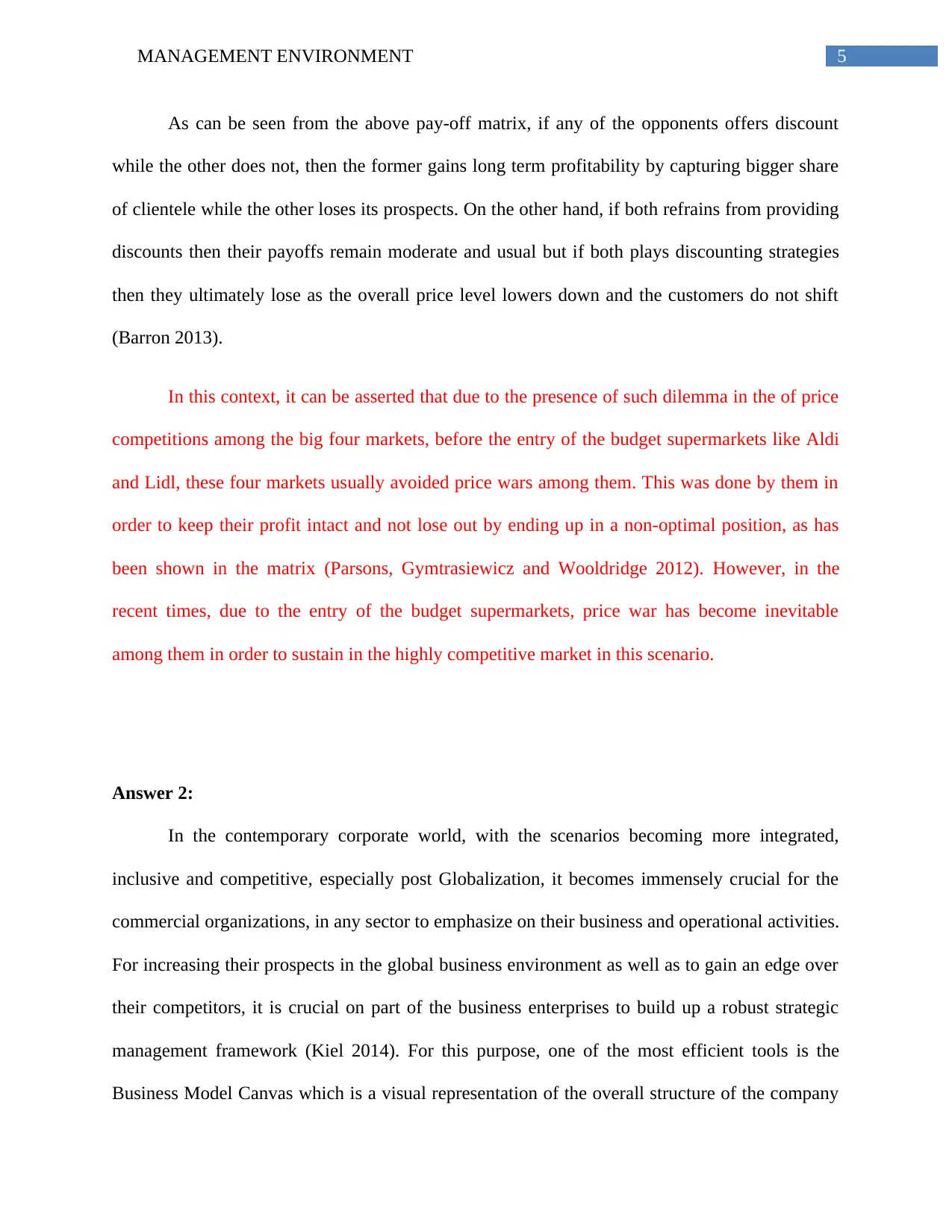
5MANAGEMENT ENVIRONMENT
As can be seen from the above pay-off matrix, if any of the opponents offers discount
while the other does not, then the former gains long term profitability by capturing bigger share
of clientele while the other loses its prospects. On the other hand, if both refrains from providing
discounts then their payoffs remain moderate and usual but if both plays discounting strategies
then they ultimately lose as the overall price level lowers down and the customers do not shift
(Barron 2013).
In this context, it can be asserted that due to the presence of such dilemma in the of price
competitions among the big four markets, before the entry of the budget supermarkets like Aldi
and Lidl, these four markets usually avoided price wars among them. This was done by them in
order to keep their profit intact and not lose out by ending up in a non-optimal position, as has
been shown in the matrix (Parsons, Gymtrasiewicz and Wooldridge 2012). However, in the
recent times, due to the entry of the budget supermarkets, price war has become inevitable
among them in order to sustain in the highly competitive market in this scenario.
Answer 2:
In the contemporary corporate world, with the scenarios becoming more integrated,
inclusive and competitive, especially post Globalization, it becomes immensely crucial for the
commercial organizations, in any sector to emphasize on their business and operational activities.
For increasing their prospects in the global business environment as well as to gain an edge over
their competitors, it is crucial on part of the business enterprises to build up a robust strategic
management framework (Kiel 2014). For this purpose, one of the most efficient tools is the
Business Model Canvas which is a visual representation of the overall structure of the company
As can be seen from the above pay-off matrix, if any of the opponents offers discount
while the other does not, then the former gains long term profitability by capturing bigger share
of clientele while the other loses its prospects. On the other hand, if both refrains from providing
discounts then their payoffs remain moderate and usual but if both plays discounting strategies
then they ultimately lose as the overall price level lowers down and the customers do not shift
(Barron 2013).
In this context, it can be asserted that due to the presence of such dilemma in the of price
competitions among the big four markets, before the entry of the budget supermarkets like Aldi
and Lidl, these four markets usually avoided price wars among them. This was done by them in
order to keep their profit intact and not lose out by ending up in a non-optimal position, as has
been shown in the matrix (Parsons, Gymtrasiewicz and Wooldridge 2012). However, in the
recent times, due to the entry of the budget supermarkets, price war has become inevitable
among them in order to sustain in the highly competitive market in this scenario.
Answer 2:
In the contemporary corporate world, with the scenarios becoming more integrated,
inclusive and competitive, especially post Globalization, it becomes immensely crucial for the
commercial organizations, in any sector to emphasize on their business and operational activities.
For increasing their prospects in the global business environment as well as to gain an edge over
their competitors, it is crucial on part of the business enterprises to build up a robust strategic
management framework (Kiel 2014). For this purpose, one of the most efficient tools is the
Business Model Canvas which is a visual representation of the overall structure of the company
⊘ This is a preview!⊘
Do you want full access?
Subscribe today to unlock all pages.

Trusted by 1+ million students worldwide
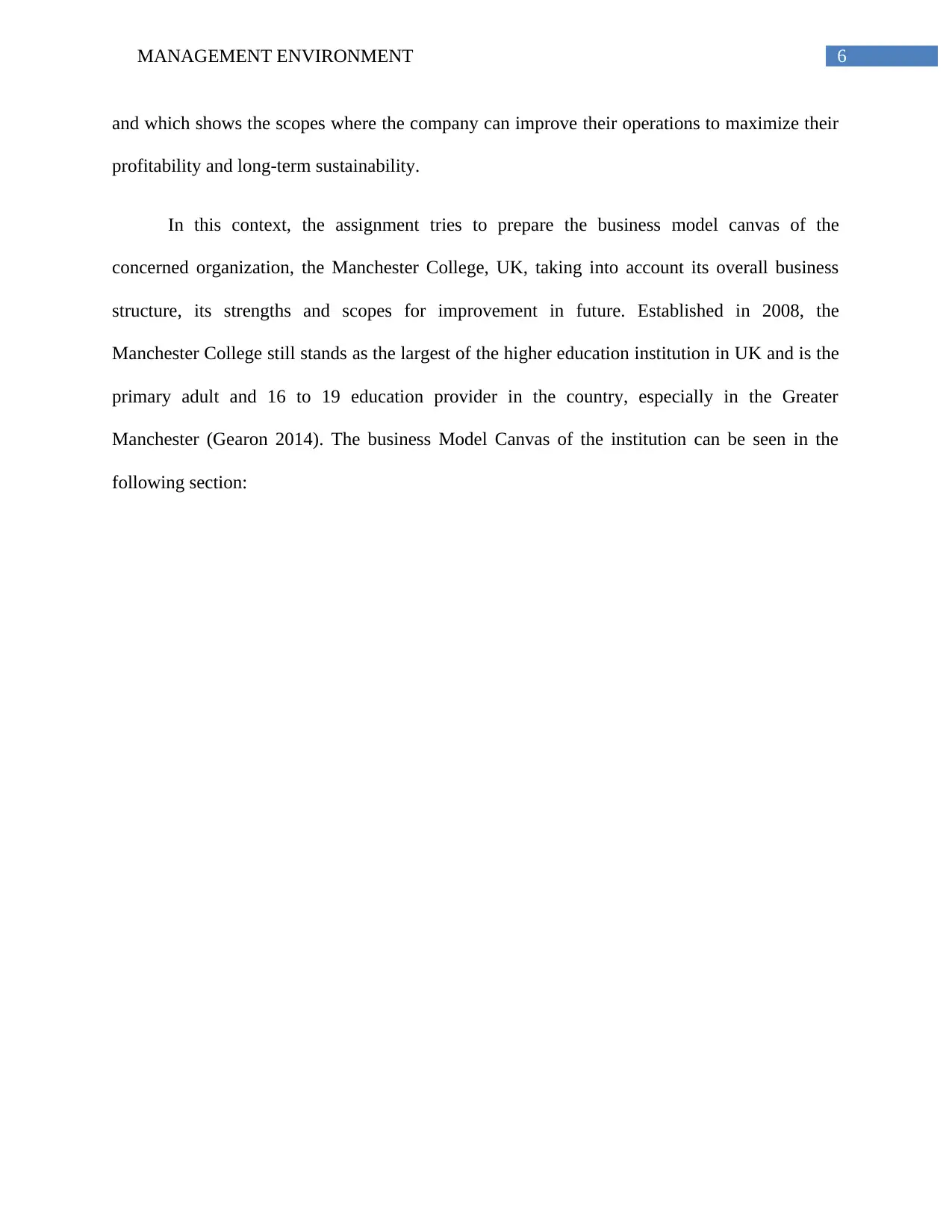
6MANAGEMENT ENVIRONMENT
and which shows the scopes where the company can improve their operations to maximize their
profitability and long-term sustainability.
In this context, the assignment tries to prepare the business model canvas of the
concerned organization, the Manchester College, UK, taking into account its overall business
structure, its strengths and scopes for improvement in future. Established in 2008, the
Manchester College still stands as the largest of the higher education institution in UK and is the
primary adult and 16 to 19 education provider in the country, especially in the Greater
Manchester (Gearon 2014). The business Model Canvas of the institution can be seen in the
following section:
and which shows the scopes where the company can improve their operations to maximize their
profitability and long-term sustainability.
In this context, the assignment tries to prepare the business model canvas of the
concerned organization, the Manchester College, UK, taking into account its overall business
structure, its strengths and scopes for improvement in future. Established in 2008, the
Manchester College still stands as the largest of the higher education institution in UK and is the
primary adult and 16 to 19 education provider in the country, especially in the Greater
Manchester (Gearon 2014). The business Model Canvas of the institution can be seen in the
following section:
Paraphrase This Document
Need a fresh take? Get an instant paraphrase of this document with our AI Paraphraser
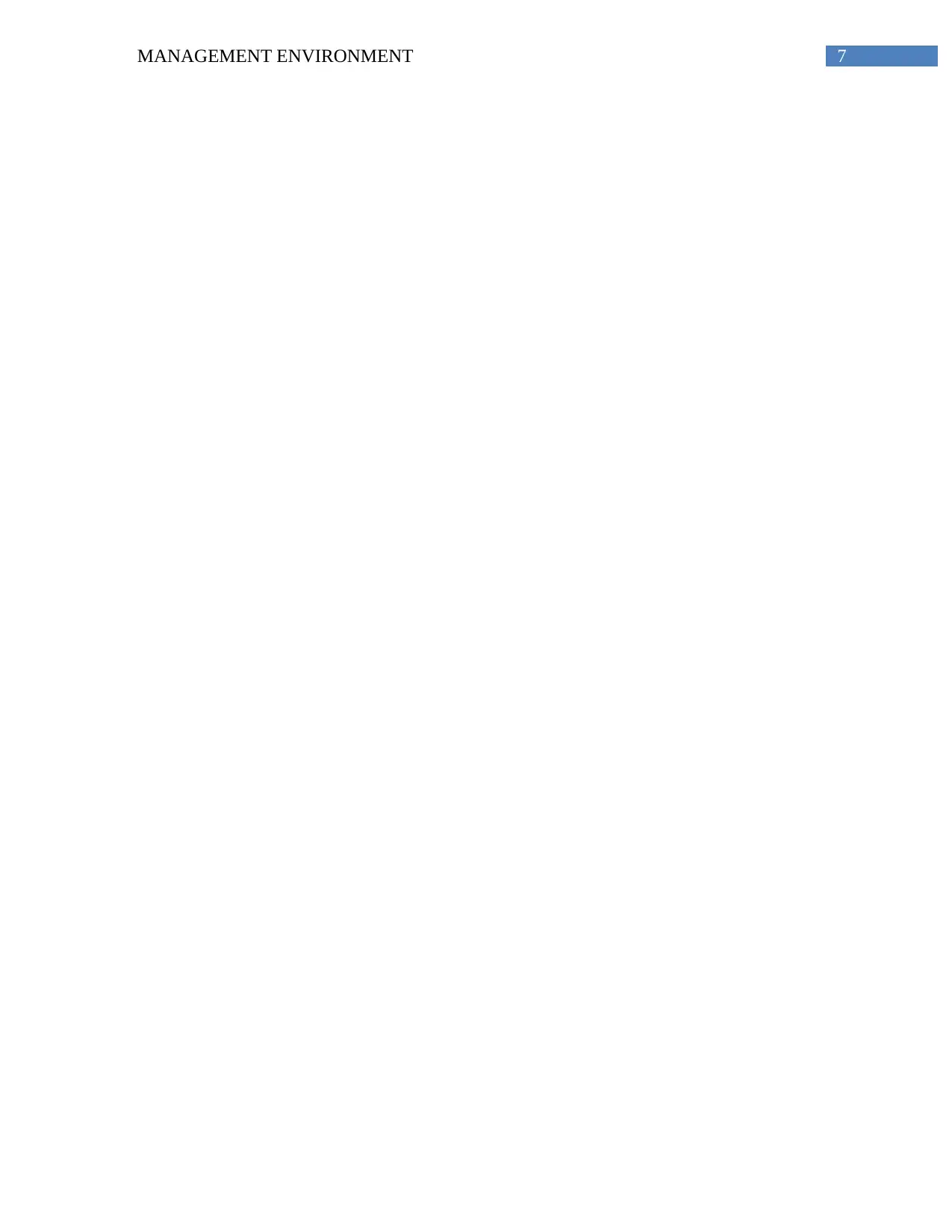
7MANAGEMENT ENVIRONMENT
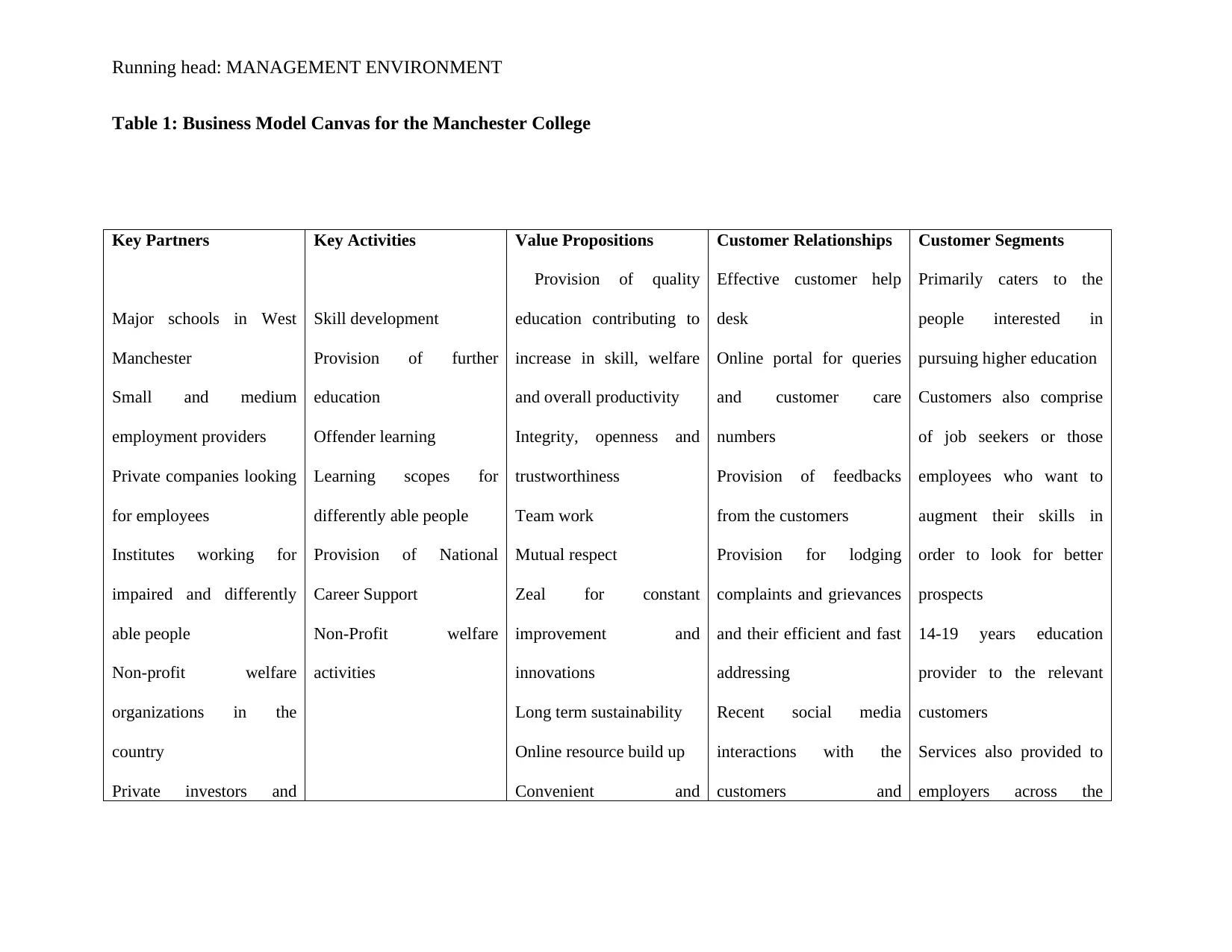
Running head: MANAGEMENT ENVIRONMENT
Table 1: Business Model Canvas for the Manchester College
Key Partners
Major schools in West
Manchester
Small and medium
employment providers
Private companies looking
for employees
Institutes working for
impaired and differently
able people
Non-profit welfare
organizations in the
country
Private investors and
Key Activities
Skill development
Provision of further
education
Offender learning
Learning scopes for
differently able people
Provision of National
Career Support
Non-Profit welfare
activities
Value Propositions
Provision of quality
education contributing to
increase in skill, welfare
and overall productivity
Integrity, openness and
trustworthiness
Team work
Mutual respect
Zeal for constant
improvement and
innovations
Long term sustainability
Online resource build up
Convenient and
Customer Relationships
Effective customer help
desk
Online portal for queries
and customer care
numbers
Provision of feedbacks
from the customers
Provision for lodging
complaints and grievances
and their efficient and fast
addressing
Recent social media
interactions with the
customers and
Customer Segments
Primarily caters to the
people interested in
pursuing higher education
Customers also comprise
of job seekers or those
employees who want to
augment their skills in
order to look for better
prospects
14-19 years education
provider to the relevant
customers
Services also provided to
employers across the
Table 1: Business Model Canvas for the Manchester College
Key Partners
Major schools in West
Manchester
Small and medium
employment providers
Private companies looking
for employees
Institutes working for
impaired and differently
able people
Non-profit welfare
organizations in the
country
Private investors and
Key Activities
Skill development
Provision of further
education
Offender learning
Learning scopes for
differently able people
Provision of National
Career Support
Non-Profit welfare
activities
Value Propositions
Provision of quality
education contributing to
increase in skill, welfare
and overall productivity
Integrity, openness and
trustworthiness
Team work
Mutual respect
Zeal for constant
improvement and
innovations
Long term sustainability
Online resource build up
Convenient and
Customer Relationships
Effective customer help
desk
Online portal for queries
and customer care
numbers
Provision of feedbacks
from the customers
Provision for lodging
complaints and grievances
and their efficient and fast
addressing
Recent social media
interactions with the
customers and
Customer Segments
Primarily caters to the
people interested in
pursuing higher education
Customers also comprise
of job seekers or those
employees who want to
augment their skills in
order to look for better
prospects
14-19 years education
provider to the relevant
customers
Services also provided to
employers across the
⊘ This is a preview!⊘
Do you want full access?
Subscribe today to unlock all pages.

Trusted by 1+ million students worldwide
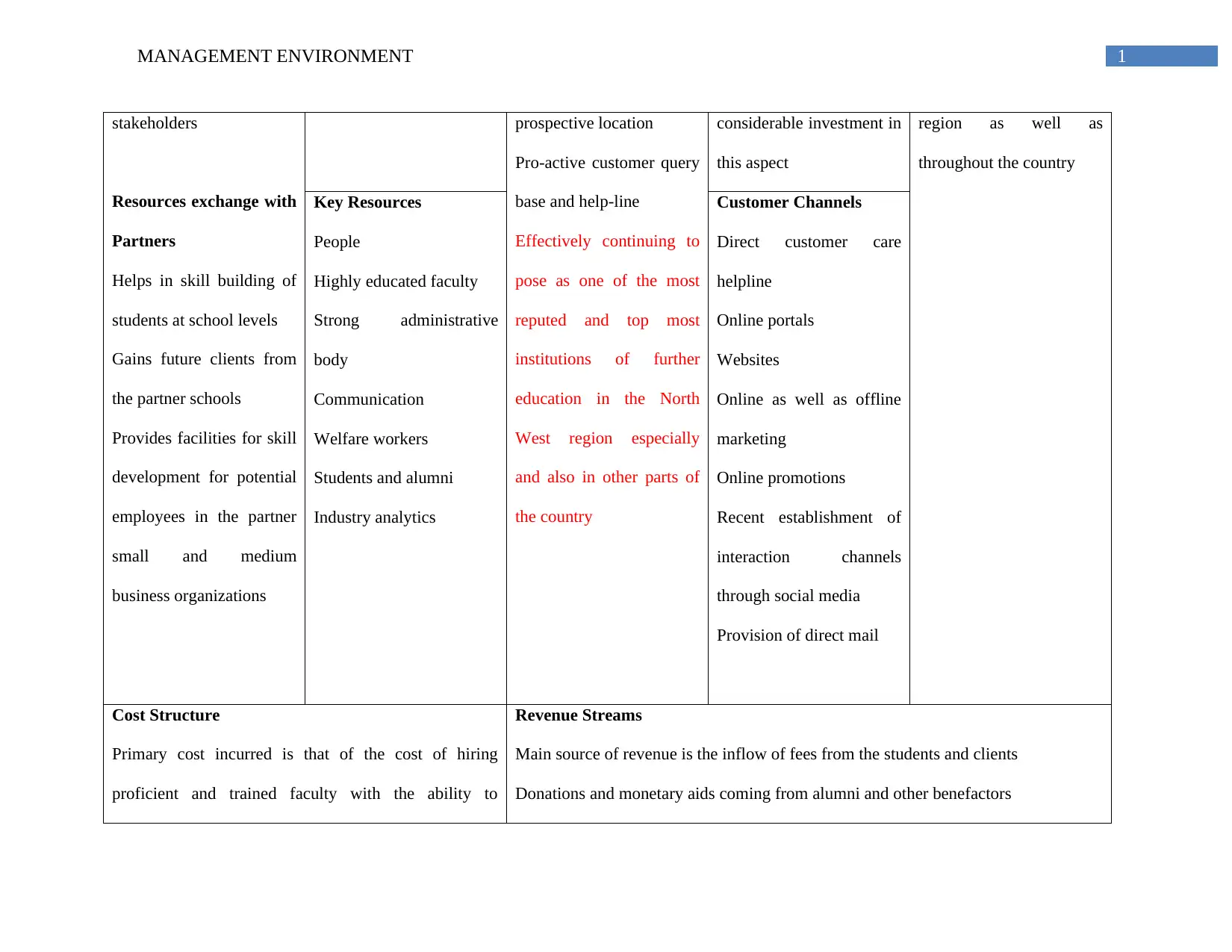
1MANAGEMENT ENVIRONMENT
stakeholders
Resources exchange with
Partners
Helps in skill building of
students at school levels
Gains future clients from
the partner schools
Provides facilities for skill
development for potential
employees in the partner
small and medium
business organizations
prospective location
Pro-active customer query
base and help-line
Effectively continuing to
pose as one of the most
reputed and top most
institutions of further
education in the North
West region especially
and also in other parts of
the country
considerable investment in
this aspect
region as well as
throughout the country
Key Resources
People
Highly educated faculty
Strong administrative
body
Communication
Welfare workers
Students and alumni
Industry analytics
Customer Channels
Direct customer care
helpline
Online portals
Websites
Online as well as offline
marketing
Online promotions
Recent establishment of
interaction channels
through social media
Provision of direct mail
Cost Structure
Primary cost incurred is that of the cost of hiring
proficient and trained faculty with the ability to
Revenue Streams
Main source of revenue is the inflow of fees from the students and clients
Donations and monetary aids coming from alumni and other benefactors
stakeholders
Resources exchange with
Partners
Helps in skill building of
students at school levels
Gains future clients from
the partner schools
Provides facilities for skill
development for potential
employees in the partner
small and medium
business organizations
prospective location
Pro-active customer query
base and help-line
Effectively continuing to
pose as one of the most
reputed and top most
institutions of further
education in the North
West region especially
and also in other parts of
the country
considerable investment in
this aspect
region as well as
throughout the country
Key Resources
People
Highly educated faculty
Strong administrative
body
Communication
Welfare workers
Students and alumni
Industry analytics
Customer Channels
Direct customer care
helpline
Online portals
Websites
Online as well as offline
marketing
Online promotions
Recent establishment of
interaction channels
through social media
Provision of direct mail
Cost Structure
Primary cost incurred is that of the cost of hiring
proficient and trained faculty with the ability to
Revenue Streams
Main source of revenue is the inflow of fees from the students and clients
Donations and monetary aids coming from alumni and other benefactors
Paraphrase This Document
Need a fresh take? Get an instant paraphrase of this document with our AI Paraphraser
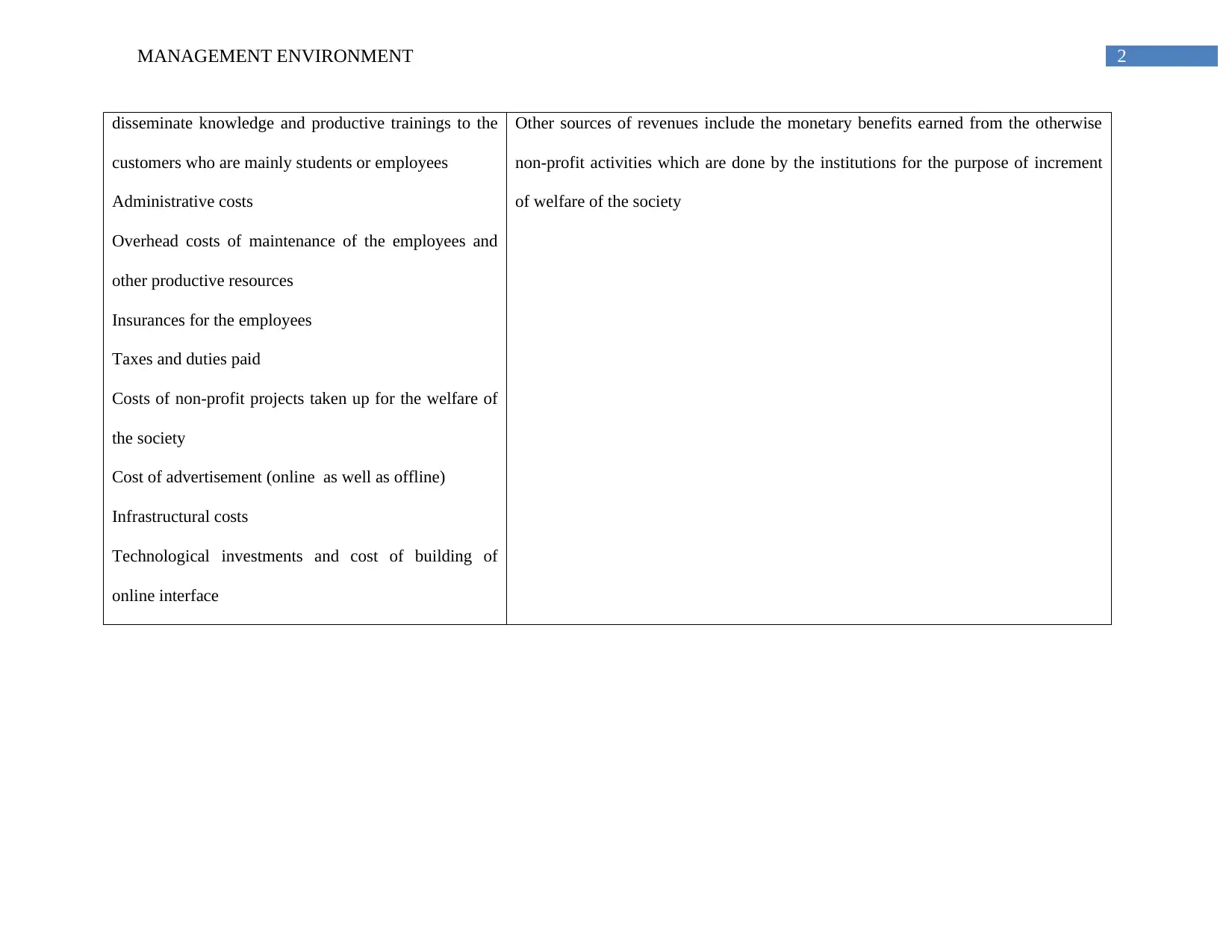
2MANAGEMENT ENVIRONMENT
disseminate knowledge and productive trainings to the
customers who are mainly students or employees
Administrative costs
Overhead costs of maintenance of the employees and
other productive resources
Insurances for the employees
Taxes and duties paid
Costs of non-profit projects taken up for the welfare of
the society
Cost of advertisement (online as well as offline)
Infrastructural costs
Technological investments and cost of building of
online interface
Other sources of revenues include the monetary benefits earned from the otherwise
non-profit activities which are done by the institutions for the purpose of increment
of welfare of the society
disseminate knowledge and productive trainings to the
customers who are mainly students or employees
Administrative costs
Overhead costs of maintenance of the employees and
other productive resources
Insurances for the employees
Taxes and duties paid
Costs of non-profit projects taken up for the welfare of
the society
Cost of advertisement (online as well as offline)
Infrastructural costs
Technological investments and cost of building of
online interface
Other sources of revenues include the monetary benefits earned from the otherwise
non-profit activities which are done by the institutions for the purpose of increment
of welfare of the society
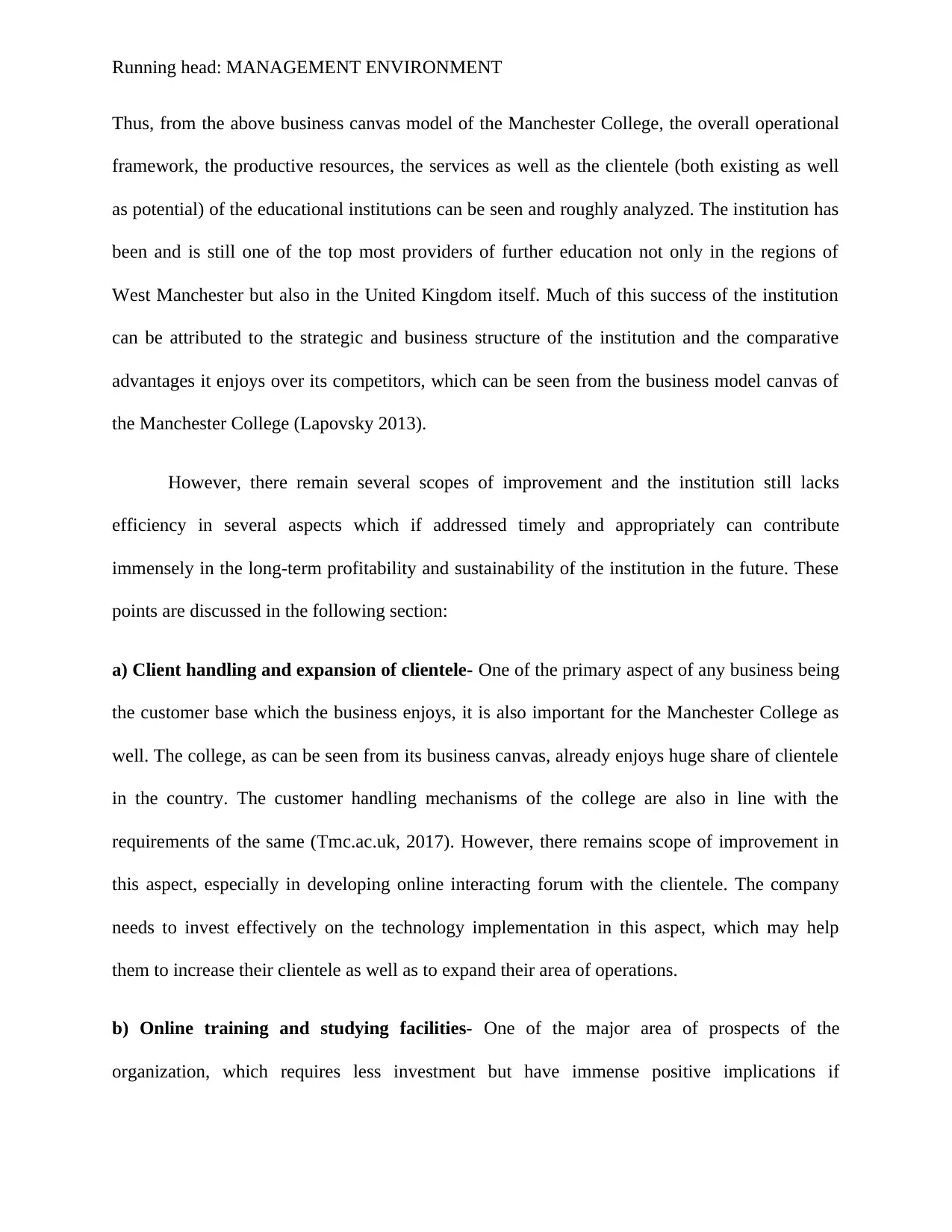
Running head: MANAGEMENT ENVIRONMENT
Thus, from the above business canvas model of the Manchester College, the overall operational
framework, the productive resources, the services as well as the clientele (both existing as well
as potential) of the educational institutions can be seen and roughly analyzed. The institution has
been and is still one of the top most providers of further education not only in the regions of
West Manchester but also in the United Kingdom itself. Much of this success of the institution
can be attributed to the strategic and business structure of the institution and the comparative
advantages it enjoys over its competitors, which can be seen from the business model canvas of
the Manchester College (Lapovsky 2013).
However, there remain several scopes of improvement and the institution still lacks
efficiency in several aspects which if addressed timely and appropriately can contribute
immensely in the long-term profitability and sustainability of the institution in the future. These
points are discussed in the following section:
a) Client handling and expansion of clientele- One of the primary aspect of any business being
the customer base which the business enjoys, it is also important for the Manchester College as
well. The college, as can be seen from its business canvas, already enjoys huge share of clientele
in the country. The customer handling mechanisms of the college are also in line with the
requirements of the same (Tmc.ac.uk, 2017). However, there remains scope of improvement in
this aspect, especially in developing online interacting forum with the clientele. The company
needs to invest effectively on the technology implementation in this aspect, which may help
them to increase their clientele as well as to expand their area of operations.
b) Online training and studying facilities- One of the major area of prospects of the
organization, which requires less investment but have immense positive implications if
Thus, from the above business canvas model of the Manchester College, the overall operational
framework, the productive resources, the services as well as the clientele (both existing as well
as potential) of the educational institutions can be seen and roughly analyzed. The institution has
been and is still one of the top most providers of further education not only in the regions of
West Manchester but also in the United Kingdom itself. Much of this success of the institution
can be attributed to the strategic and business structure of the institution and the comparative
advantages it enjoys over its competitors, which can be seen from the business model canvas of
the Manchester College (Lapovsky 2013).
However, there remain several scopes of improvement and the institution still lacks
efficiency in several aspects which if addressed timely and appropriately can contribute
immensely in the long-term profitability and sustainability of the institution in the future. These
points are discussed in the following section:
a) Client handling and expansion of clientele- One of the primary aspect of any business being
the customer base which the business enjoys, it is also important for the Manchester College as
well. The college, as can be seen from its business canvas, already enjoys huge share of clientele
in the country. The customer handling mechanisms of the college are also in line with the
requirements of the same (Tmc.ac.uk, 2017). However, there remains scope of improvement in
this aspect, especially in developing online interacting forum with the clientele. The company
needs to invest effectively on the technology implementation in this aspect, which may help
them to increase their clientele as well as to expand their area of operations.
b) Online training and studying facilities- One of the major area of prospects of the
organization, which requires less investment but have immense positive implications if
⊘ This is a preview!⊘
Do you want full access?
Subscribe today to unlock all pages.

Trusted by 1+ million students worldwide
1 out of 24
Related Documents
Your All-in-One AI-Powered Toolkit for Academic Success.
+13062052269
info@desklib.com
Available 24*7 on WhatsApp / Email
![[object Object]](/_next/static/media/star-bottom.7253800d.svg)
Unlock your academic potential
Copyright © 2020–2025 A2Z Services. All Rights Reserved. Developed and managed by ZUCOL.





